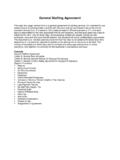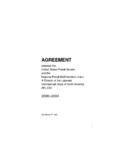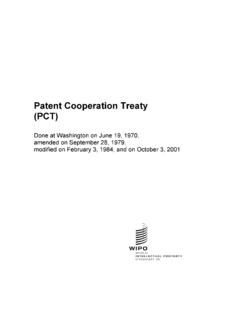Transcription of OECD/G20 Base Erosion and Profit Shifting Project …
1 OECD/G20 Base Erosion and Profit Shifting ProjectExplanatory Statement2015 Final ReportsOECD/G20 Base Erosion and Profit Shifting ProjectExplanatory StatementAddressing base Erosion and Profit Shifting is a key priority of governments around the globe. In 2013, OECD and G20 countries, working together on an equal footing, adopted a 15-point Action Plan to address BEPS. Beyond securing revenues by realigning taxation with economic activities and value creation, the OECD/G20 BEPS Project aims to create a single set of consensus-based international tax rules to address BEPS, and hence to protect tax bases while offering increased certainty and predictability to taxpayers. A key focus of this work is to eliminate double non-taxation. However in doing so, new rules should not result in double taxation, unwarranted compliance burdens or restrictions to legitimate cross-border Base Erosion and Profit Shifting Project explanatory Statement Please cite this publication as: OECD (2015), explanatory Statement, OECD/G20 Base Erosion and Profit Shifting Project , OECD.
2 Photo credits: Cover ninog / OECD 2015 You can copy, download or print OECD content for your own use, and you can include excerpts from OECD publications, databases and multimedia products in your own documents, presentations, blogs, websites and teaching materials, provided that suitable acknowledgment of the source and copyright owner is given. All requests for public or commercial use and translation rights should be submitted to Requests for permission to photocopy portions of this material for public or commercial use shall be addressed directly to the Copyright Clearance Center (CCC) at or the Centre fran ais d'exploitation du droit de copie (CFC) at TABLE OF CONTENTS 3 explanatory STATEMENT OECD 2015 Table of contents Introduction.
3 4 Achievements of the BEPS Project .. 5 Post-BEPS Environment .. 9 A. Implementation starts now .. 9 B. Monitoring implementation and impact .. 10 C. Designing an inclusive framework .. 11 D. Next steps .. 11 Annex A. Overview of BEPS Package .. 13 Action 1 Address the Tax Challenges of the Digital Economy .. 13 Action 2 Neutralise the Effects of Hybrid Mismatch Arrangements .. 13 Action 3 Strengthen CFC Rules .. 13 Action 4 Limit Base Erosion via Interest Deductions and Other Financial Payments .. 14 Action 5 Counter Harmful Tax Practices More Effectively, Taking into Account Transparency and Substance .. 14 Action 6 Prevent Treaty Abuse .. 14 Action 7 Prevent the Artificial Avoidance of PE Status .. 15 Actions 8-10 Assure that Transfer Pricing Outcomes are in Line with Value Creation.
4 15 Action 11 Measuring and Monitoring BEPS .. 16 Action 12 Require Taxpayers to Disclose their Aggressive Tax Planning Arrangements .. 16 Action 13 Re-examine Transfer Pricing Documentation .. 17 Action 14 Make Dispute Resolution Mechanisms More Effective .. 17 Action 15 Develop a Multilateral Instrument .. 18 Notes .. 19 4 explanatory STATEMENT explanatory STATEMENT OECD 2015 Introduction 1. International tax issues have never been as high on the political agenda as they are today. The integration of national economies and markets has increased substantially in recent years. This has put a strain on the international tax framework, which was designed more than a century ago. The current rules have revealed weaknesses that create opportunities for Base Erosion and Profit Shifting (BEPS), thus requiring a bold move by policy makers to restore confidence in the system and ensure that profits are taxed where economic activities take place and value is created.
5 In September 2013, G20 Leaders endorsed the ambitious and comprehensive Action Plan on BEPS. This package of 13 reports, delivered just 2 years later, includes new or reinforced international standards as well as concrete measures to help countries tackle BEPS. It represents the results of a major and unparalleled effort by OECD and G20 countries1 working together on an equal footing with the participation of an increasing number of developing countries. 2. The stakes are high. Although measuring the scope of BEPS proves challenging, the findings of the work performed since 2013 confirm the potential magnitude of the issue, with estimates indicating that the global corporate income tax (CIT) revenue losses could be between 4% to 10% of global CIT revenues, USD 100 to 240 billion annually.
6 The losses arise from a variety of causes, including aggressive tax planning by some multinational enterprises (MNEs), the interaction of domestic tax rules, lack of transparency and coordination between tax administrations, limited country enforcement resources and harmful tax practices. The affiliates of MNEs in low tax countries report almost twice the Profit rate (relative to assets) of their global group, showing how BEPS can cause economic distortions. Estimates of the impact of BEPS on developing countries, as a percentage of tax revenues, are higher than in developed countries given developing countries greater reliance on CIT revenues. In a globalised economy, governments need to cooperate and refrain from harmful tax practices, to address tax avoidance effectively, and provide a more certain international environment to attract and sustain investment.
7 Failure to achieve such cooperation would reduce the effectiveness of CIT as a tool for resource mobilisation, which would have a disproportionately harmful impact on developing countries. 3. This BEPS package, which includes and consolidates the first seven reports presented to and welcomed by the G20 Leaders at the Brisbane Summit in 2014, has been developed and agreed in just two years. This is chiefly because there is an urgent need to restore the trust of ordinary people in the fairness of their tax systems, to level the playing field among businesses, and to provide governments with more efficient tools to ensure the effectiveness of their sovereign tax policies. It was also imperative to move quickly to try to limit the risks of countries taking uncoordinated unilateral measures which might weaken key international tax principles which form a stable framework for cross-border investments.
8 BEPS can result in double non-taxation but addressing BEPS should not result in double taxation. Double taxation would harm MNEs which have contributed to boosting trade and investment around the world, supporting growth, creating jobs, fostering innovation and providing pathways out of poverty. Double taxation would also increase the cost of capital and could deter investment in the economies concerned. 4. The level of interest and participation in the work has been unprecedented with more than 60 countries2 directly involved in the technical groups and many more participating in shaping the outcomes through regional structured dialogues. Regional tax explanatory STATEMENT 5 explanatory STATEMENT OECD 2015 organisations such as the African Tax Administration Forum (ATAF), Centre de rencontre des administrations fiscales (CREDAF) and the Centro Interamericano de Administraciones Tributarias (CIAT) joined international organisations like the International Monetary Fund (IMF), the World Bank (WB) and the United Nations (UN), in contributing to the work.
9 Stakeholder interest including invaluable interactions with business and civil society saw more than 12 000 pages of comments received on the 23 discussion drafts published and discussed at 11 public consultations, as well as more than 40 000 views of the OECD webcasts on BEPS. 5. The report Addressing Base Erosion and Profit Shifting (OECD, 2013) concluded that no single tax rule on its own enables BEPS; it is rather the interplay among different issues that makes it possible. Domestic laws and rules that are not co-ordinated across borders, international tax standards that have not always kept pace with the changing global business environment and a pervasive lack of relevant information at the level of tax administrations and policy makers combine to provide opportunities for taxpayers to undertake BEPS strategies.
10 The availability of harmful tax practices was also identified as a key pressure area. 6. Out of a shared desire to address BEPS concerns, there is agreement on a comprehensive package of measures which are designed to be implemented domestically and through treaty provisions in a coordinated manner, supported by targeted monitoring and strengthened transparency. The goal is to tackle BEPS structures by comprehensively addressing their root causes rather than merely the symptoms. 7. Once the measures are implemented, many schemes facilitating double non-taxation will be curtailed. The implementation of the BEPS package will better align the location of taxable profits with the location of economic activities and value creation, and improve the information available to tax authorities to apply their tax laws effectively.















